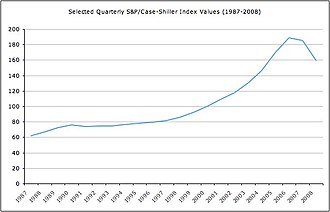Credit crunch
Credit Crunch refers to a sudden reduction in the general availability of loans or a sudden tightening of the conditions required to obtain a loan from the banks. It often occurs when lenders become wary about lending money to individuals, businesses, or other banks due to fears that the borrowers will not be able to repay the loans. This phenomenon can lead to a significant slowdown in economic activity as companies and individuals are unable to secure financing for operations, purchases, or investments.
Causes
The causes of a credit crunch can be multifaceted and complex, often involving a combination of economic, regulatory, and psychological factors. Key causes include:
- Financial crisis: A major financial crisis can lead to a credit crunch as banks suffer from losses and become reluctant to lend.
- Changes in regulation: Tighter financial regulations or capital requirements can lead banks to reduce lending.
- Risk aversion: In times of economic uncertainty, lenders may become more risk-averse, tightening lending standards.
- Asset price collapse: A significant drop in asset prices can reduce the value of collateral, leading banks to reduce lending.
Effects
The effects of a credit crunch can be widespread and damaging:
- Economic slowdown: Reduced lending can lead to lower investment and consumption, slowing down economic growth.
- Increased unemployment: Businesses unable to secure loans may cut back on expansion or operations, leading to job losses.
- Bank failures: A severe credit crunch can lead to bank failures if banks are unable to recover loans and face liquidity issues.
Responses
Governments and central banks have several tools at their disposal to respond to a credit crunch:
- Monetary policy easing: Central banks may lower interest rates or engage in quantitative easing to increase the money supply and encourage lending.
- Fiscal stimulus: Governments may increase spending or cut taxes to stimulate economic activity.
- Bank bailouts: Direct financial support to banks can help stabilize the banking sector and encourage lending.
Historical Examples
Several notable credit crunches have occurred in recent history:
- Early 1990s: A credit crunch hit the United States following the savings and loan crisis, affecting commercial real estate lending.
- Global Financial Crisis (2007-2008): The collapse of the subprime mortgage market in the United States led to a global credit crunch, significantly impacting global economic activity.
See Also
Transform your life with W8MD's budget GLP-1 injections from $125.
W8MD offers a medical weight loss program to lose weight in Philadelphia. Our physician-supervised medical weight loss provides:
- Most insurances accepted or discounted self-pay rates. We will obtain insurance prior authorizations if needed.
- Generic GLP1 weight loss injections from $125 for the starting dose.
- Also offer prescription weight loss medications including Phentermine, Qsymia, Diethylpropion, Contrave etc.
NYC weight loss doctor appointments
Start your NYC weight loss journey today at our NYC medical weight loss and Philadelphia medical weight loss clinics.
- Call 718-946-5500 to lose weight in NYC or for medical weight loss in Philadelphia 215-676-2334.
- Tags:NYC medical weight loss, Philadelphia lose weight Zepbound NYC, Budget GLP1 weight loss injections, Wegovy Philadelphia, Wegovy NYC, Philadelphia medical weight loss, Brookly weight loss and Wegovy NYC
|
WikiMD's Wellness Encyclopedia |
| Let Food Be Thy Medicine Medicine Thy Food - Hippocrates |
Medical Disclaimer: WikiMD is not a substitute for professional medical advice. The information on WikiMD is provided as an information resource only, may be incorrect, outdated or misleading, and is not to be used or relied on for any diagnostic or treatment purposes. Please consult your health care provider before making any healthcare decisions or for guidance about a specific medical condition. WikiMD expressly disclaims responsibility, and shall have no liability, for any damages, loss, injury, or liability whatsoever suffered as a result of your reliance on the information contained in this site. By visiting this site you agree to the foregoing terms and conditions, which may from time to time be changed or supplemented by WikiMD. If you do not agree to the foregoing terms and conditions, you should not enter or use this site. See full disclaimer.
Credits:Most images are courtesy of Wikimedia commons, and templates, categories Wikipedia, licensed under CC BY SA or similar.
Translate this page: - East Asian
中文,
日本,
한국어,
South Asian
हिन्दी,
தமிழ்,
తెలుగు,
Urdu,
ಕನ್ನಡ,
Southeast Asian
Indonesian,
Vietnamese,
Thai,
မြန်မာဘာသာ,
বাংলা
European
español,
Deutsch,
français,
Greek,
português do Brasil,
polski,
română,
русский,
Nederlands,
norsk,
svenska,
suomi,
Italian
Middle Eastern & African
عربى,
Turkish,
Persian,
Hebrew,
Afrikaans,
isiZulu,
Kiswahili,
Other
Bulgarian,
Hungarian,
Czech,
Swedish,
മലയാളം,
मराठी,
ਪੰਜਾਬੀ,
ગુજરાતી,
Portuguese,
Ukrainian
Contributors: Prab R. Tumpati, MD



